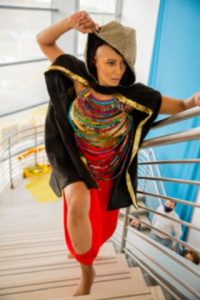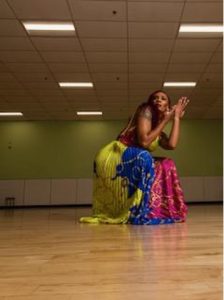4 A’Keitha Carey
Autumn Pearson
A’Keitha Carey
Narrative and Interview by Autumn Pearson

A’kietha Carey was born in the Bahamas and grew up watching and partaking in all of the Caribbean social dances. Eventually she moved to the United States where she was able to continue her studies in dance before moving back to the Bahamas for a small portion of her life. Carey attended Florida International University and Florida State University where she earned an MFA in Dance. Currently, Carey is working toward dual degrees at Florida International: a Master’s degree in African and African Diaspora. Carey also holds a certificate in Women’s Studies from Texas Woman’s University. Carey is a certified Zumba instructor and a dance teacher. After a knee injury, she was told that if she wanted to dance at the same level that she used to, she would need to incorporate more fitness into her life. This was the impetus for Carey to create her own dance and movement form, CaribFunk.
CaribFunk is a combination of classical styles, Bahamian social dance, and African diaspora dances, as well as being structured as a fitness class. Carey vividly described how she was using her time teaching CaribFunk as a way of sharing different cultures and sharing the roots of a lot of diverse styles of dance.
A’keitha Carey resides in south Florida, a place in which she describes very few dance schools offer African diaspora dance classes or other cultural dances such as Haitian dance. One of her future goals for her dance teaching is to start an institution for the dance style and for other African diaspora styles. She is exploring three institutional models to develop her own; she explains that she would want to open said institution in south Florida since she sees the biggest need for it there. She also perceives the need for the institution in south Florida to combat the racism there. The racism in south Florida, she says, is largely due to media portrayal and misrepresentations of Miami and Latin cultures there.
A’Keitha Carey reminds me of Katherine Dunham. When Katherine Dunham came back to US-America after her studies in Latin America, she was turned down by many dance spectators for adopting a new movement quality. Dunham had learned and begun incorporating more pelvic movements and adding a more sensual flair to her dancing. Carey has dealt with similar battles. In an interview, Carey mentioned how a lot of people still are not comfortable recognizing dancing with the hips and pelvis as dancing, and how a lot of elders in the dance world are still not comfortable with that type of movement. I was lucky to get the chance to interview this amazing woman.
Please share how long you have been choreographing and/or producing dance and what led you to this career path.
Carey: Although I had initially gone to school for a degree in the medical field, I was still taking a lot of dance classes. Eventually I ended up changing my degree plan to involve dance. I was offered a job right out of graduate school and began teaching in 1998. Along my timeline, I got Zumba certified and also began teaching that as well. Unfortunately, in 2003, I suffered an ACL injury that set me back a few steps. I was told if I wanted to dance at the level I was at prior to the injury, I’d have to add in more exercise/cardio. So I started CaribFunk, which has been on the rise from my first teaching job at a summer program in 1998.
How/where do you find inspiration?
Carey: Pulling from Bahamian social dances, African diaspora dances, and other classical training styles such as ballet and jazz; I was able to create my style of CaribFunk, which is not just a dance style, it is also a workout regimen. I find inspiration from all around me and especially from other cultures. I am the never-ending student, always searching for more and new information about where these dance forms came from.
What are the steps you take in making a new dance?
Carey: I’m clear about the movement [vocabulary of CaribFunk] now, so that’s not a struggle anymore. For me, if I’m brought in to do a residency to set a work, the first thing that we do is we go through the movement technique because I want to see where people’s hang ups are-where there’s freedom, where they are empowered, where they are liberated, particularly. When we start the rotation of the pelvis and start having these conversations . . . My movement is very sensual. There’s a lot in the way that I’m asking dancers to respond to the music, to see and to hear, to smell, that I do a lot of visualization. I also think it’s important to know your entry point [as a choreographer] and do lots of research.
What is your process for selecting and working with dancers or dance students?
Carey: Since I am on a hiatus of some sort from choreographing at the current moment, I can speak to past experiences. In most of my experiences, it depends on time and resources for both me and others working with me. I care about helping people through their hang ups with my choreography and process.

What does success mean to you in your role as a choreographer/teacher/producer?
Carey: When I feel like the person tells me that they felt a sense of freedom and liberation, sometimes coming from a different framework . . . But again, it’s about the entry point: How are you entering [the dance]? And what are you getting from the experience? So, when they share with me how they’ve been allowed to either be free or how they have been able to use the movement vocabulary to reclaim their sensuality or sexuality or femininity or their awareness . . . Those are the moments for me that I feel it was successful, because at the end of the day I want students to feel like they are able to be free and uncensored in that space. We have a lot of conversation about languaging because we talk about policing and the female body, specifically, the black female body, the politics behind that the history. What the gaze means, when that happens, and how you address it, giving them the tools and the language and the authority over their bodies to speak very freely and very clearly about what’s happening, what this narrative is, and who is in control of the narrative. Because my thing is, at the end of the day, no matter how I move my body, you are going to interpret it whatever way that you want to. But that doesn’t change my intention and it shouldn’t change the way that I perform because you have maybe a varying understanding or perception of what it is that in doing.
What have been your biggest challenges and successes as a choreographer/teacher/producer?
Carey: Well, I think a lot of the challenges that I have are related to the fact that I have primarily worked in predominantly white institutions. My first academic job I ended up resigning from because of issues related to this. My health had deteriorated so badly that I had to make a decision-like a life-or-death decision. Was it worth my health to stay in this institution that did not support me? That did their best to kind of ruin me? I have also faced microaggressions in different work environments as well a lot of disapproval of my movement because it incorporates a lot of hip and sensual moves.
Why is dance important and what are your hopes for the field and for yourself?
Carey: When I talk about that, I describe it as long and short-term goals. My vision for CaribFunk is to have my own institution which would serve multiple purposes. The second part is curation-presenting artists of the African diaspora who are making work that speaks to the culture. I’m also interested in a certificate program in African diaspora dance forms. I’m also interested in creating a digital archive. I would like to see a change in the institution-both in dance and education. The current people in power are afraid to relinquish it and are afraid to look at things in a new light.

Takeaways: A’Keitha Carey’s Impact
It’s not hard to see that A’kietha Carey is very passionate about what she does and what she is putting into the world. I could also see just how excited for the future she was-excited for future dancers. During our interview, A’keitha was more than happy to offer advice for a young Black woman dancer and eager to learn my own story. It’s clear to anyone who meets her, A’keitha is proud of her heritage and proud of what she has created.
A’Keitha Carey’s Professional Website: http://www.caribfunk.com/who-is-akeitha-carey.html
Instagram: @caridance100
Twitter: @AKEITHAC
Works Cited
Canvas Rebel. “Meet A’Keitha Carey.” August 4, 2022. Accessed 17 Oct. 2022. canvasrebel.com/meet-akeitha-carey/.
“Daily Inspiration: Meet A’Keitha Carey.” VoyageMia, 4 Feb. 2021, voyagemia.com/interview/daily-inspiration-meet-akeitha-carey/. Accessed 17 Oct. 2022.
Olujimi Dance Collective. Accessed October 17, 2022. www.olujimidancecollective.com/artist-bios.html.

